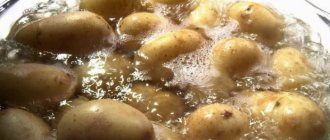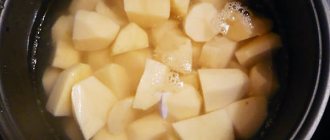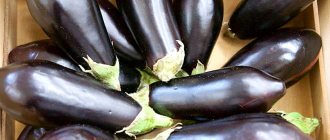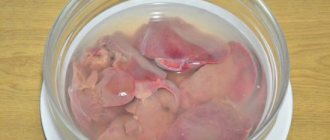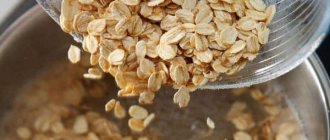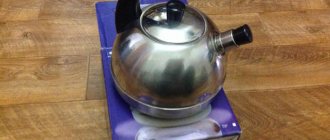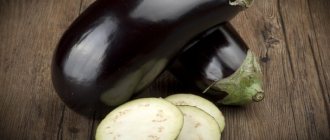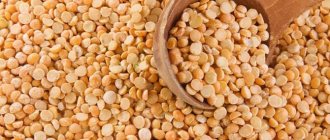What actually happens to potatoes when they are soaked in water? And who needs to do this?
Photo: Footage.framepool.com
Photo: Footage.framepool.com
Soaking vegetables is a simple and effective way to reduce nitrates. Up to 25 percent of these substances are concentrated on the surface of the peel. Being water soluble, they dissolve into room temperature water within an hour, making the product safer. An even safer option is to cut off the peel to remove up to 80 percent of the hazardous substances if you plan to eat the vegetable fresh. Or subject it to heat treatment: boil, stew, fry. In this case, there are no nitrates left in the vegetables at all.
Potatoes, unlike other vegetables, are not eaten fresh. Therefore, there is no point in soaking it to “remove harmful substances.” When boiling, baking and frying, nitrates are quickly destroyed; from this point of view, the root vegetable is absolutely safe. It is considered dubious for another reason - due to its high starch content.
When potatoes are boiled, nitrates are destroyed (Photo: Footage.framepool.com)
When potatoes are boiled, nitrates are destroyed (Photo: Footage.framepool.com)
Are soaked potatoes healthy?
There is an opinion that potatoes consist mainly of water and starch. If the latter is eliminated, the tuber loses all nutritional value. This judgment is incorrect, since 100 g of the product contains:
- Silicon - 50 mg, or 170% of the daily value (DV). Thanks to the microelement, the skin becomes more elastic, blood vessels - elastic, hair and nails - strong.
- Boron - 115 mcg, or 164% s/n. By maintaining the required level of boron, bones will be strong, despite age-related changes. Women during menopause need boron to improve memory, relieve stress and prevent osteoporosis.
- Vanadium - 150 mcg, or 370% s/n. Normalizes cholesterol levels in the blood, takes part in redox processes in the body. Essential for athletes and people trying to lose weight.
- Rubidium - 500 mcg, or 500% s/n. The trace element helps strengthen the nervous system, has antihistamine properties, and increases blood pressure.
In addition to substances, the content of which in 100 g covers the daily needs of the human body, potatoes contain vitamins (B6, B9, C, PP, K), microelements (cobalt, lithium, manganese, chromium), omega-3.
Potatoes contain a lot of starch. Its volume is 15–17% of the mass. It is a polysaccharide that is converted into glucose in the stomach. People with diabetes or overweight, children, and people with allergies should avoid foods that increase blood sugar levels. If starch is eliminated, consumption of the product will become possible for them.
Harm and contraindications
Despite the many medicinal qualities, potatoes can cause harm to the body. The main contraindications include:
- Increased individual sensitivity. Allergy to potatoes is quite rare and is characterized by a mild course.
- Having diabetes or obesity. Potatoes contain small amounts of simple carbohydrates. When these substances are consumed in excess, the course of these diseases worsens. The recommended maximum portion of potatoes in the total daily diet is up to 10%.
- Gastritis with low acidity or atrophic gastritis. With these forms of damage to the gastric mucosa, potatoes are a powerful irritant that can aggravate the course.
- Taking beta blockers. This group of medications, prescribed for various pathologies of the heart and blood vessels, leads to an increase in potassium levels in the blood. Potatoes are also rich in this element. Hyperkalemia can cause seizures or cardiac arrest.
In the absence of the contraindications described above, potatoes can be consumed by women during pregnancy. It contains a number of substances (especially vitamin C and folic acid) that are necessary for the proper development of fetal organs, preventing the appearance of malformations, as well as reducing the risk of infectious diseases, both in the body of the unborn child and the mother.
When consuming potatoes, several subtleties must be taken into account in order to reduce the risk of side effects to zero:
- Avoid green root vegetables. Potatoes that have been exposed to sunlight accumulate solanine and have a green color. Solanine is an extremely toxic substance that reduces the activity of the respiratory and cardiovascular centers in the medulla oblongata.
- Avoid cooking temperatures that are too high. Heating to 120 degrees and above leads to the accumulation of acrylamide in the pulp, which increases the risk of developing malignant diseases several times and has a neurotoxic effect.
- Inquire about growing conditions. Potatoes are capable of actively accumulating toxic substances from the soil or the external environment.
Potatoes have a certain list of contraindications, side effects and preparation details that should be taken into account in order to prevent complications.
Why do potato tubers become crumbly when cooked for a long time?
Boiled potatoes are delicious boiled with butter. Knowing what dish it is purchased for, you can choose the appropriate variety.
Tubers with tough skin and yellow flesh contain less starch and are suitable for stir-frying and salads. But for mashed potatoes or thick soup, potatoes with tough skin and pale flesh are the ideal choice. It crumbles perfectly and has high nutritional value.
If you want to fry potatoes, don't choose starchy tubers. This will not have a golden brown crust, and the slices will fall apart into mush - dinner and your mood will be ruined. When purchasing, pay attention to the skin and pulp on the cut.
Cooking recommendations
If eating potatoes is not associated with the occurrence of negative reactions, you can eat them every day, but not more than 200 g. People with high blood sugar, gout and young children should limit their consumption to 100 g per week. Regardless of the cooking method, it is better to soak the potatoes.
To maintain the usefulness of the product and achieve the best taste, you can use the following tips:
- To prevent the skin of the tuber in its uniform from bursting, add a couple of drops of vinegar to the water.
- To speed up cooking, add a piece of butter (margarine) to the pan.
- To make the tubers lighter, you need to add 1 tsp during cooking. lemon juice.
- Purees should be eaten fresh. During heat treatment, it loses 30% of vitamin C, and when heated again, there will be no vitamins left in it.
- To obtain tasty and crumbly boiled potatoes, you need to pour salted boiling water over the soaked tubers.
- To minimize the amount of nitrates in store-bought potatoes, it is necessary to remove the skin in a thick layer. For an environmentally friendly product, another rule is to peel it as thinly as possible, and better yet, eat it with the peel, since it contains more vitamins than a peeled tuber.
- Frozen potatoes will lose their unpleasant taste if they are consumed no earlier than a week after storage at room temperature.
- Soaked potatoes are good to eat raw. It is recommended for cancer patients, people with increased swelling, metabolic disorders, and gum disease. Grated tubers can be mixed with apples and seasoned with lemon juice and honey. An important condition is the absence of pesticides.
Potatoes allow you to diversify your menu and saturate your body with useful microelements. If according to indications the tubers are prohibited from being eaten, soaking will correct the situation. Without starch and pesticides, potatoes are good for everyone.
Potatoes are the most popular root vegetable. Since childhood, everyone knows that potatoes are the second bread. Most people grow it in their gardens, while others buy it in stores. This root vegetable is included in a huge number of dishes. Experienced chefs recommend soaking it before cooking. First of all, this applies to purchased potatoes. This article will tell you how and why to do this.
Potato allergy symptoms
A potato allergy can present with a range of symptoms. These may include gastrointestinal reactions (intestinal disorders), rhinitis, sneezing, itching and burning in the mouth. In addition, manifestations of contact dermatitis, eczema, hives and even asthma attacks are possible. An allergy to potatoes can cause very severe headaches and even, as already mentioned, anaphylactic shock.
It is important to note that a reaction can occur even with indirect contact. In children, for example, allergic manifestations may appear if the child is in the kitchen where potatoes are peeled.
So, an allergy to potatoes can manifest itself with the following symptoms:
- difficulty swallowing;
- hoarseness;
- swelling of the lips, tongue, throat and face;
- asthma;
- hives;
- cough, sneezing;
- redness, toothache and soreness of the eyes;
- runny nose;
- nausea, vomiting, diarrhea;
- dyspnea;
- headaches, sleep disturbances, dizziness;
- itching and tingling in the mouth.
The earliest and most typical symptoms are redness and a small rash on the skin around the mouth, itching in the mouth, swelling of the mucous membrane. These signs usually appear immediately after eating potatoes. Also quite often, an allergy to potatoes is manifested by abnormalities in the gastrointestinal tract. We are talking about symptoms such as lack of appetite, nausea, vomiting, upset stool, stabbing pain in the abdomen.
Potato soaking technique
During soaking, the starchy masses are partially washed out of the tubers. They come out of the root pulp and concentrate on the surface. The longer the tubers are in water, the more starch they lose. To get rid of starchy compounds, proceed as follows.
- Wash the potatoes, peel them or leave them in them.
- Cut the tubers into four parts.
- Fill with cold running water until it just covers the pieces.
- Leave for an hour, drain the water.
- Fill with water for another hour, drain, and rinse the potatoes.
When soaked, potatoes lose most of their starches (Photo: Kakxranit.ru)
There are especially a lot of starchy substances in last year's potatoes: during storage, the composition of the pulp changes. The root vegetable produces starches to provide nutrition to the sprouts. There is practically no starch in new potatoes, so there is no need to soak them.
Why soak potatoes?
Tubers should be soaked for the following reasons:
- As you know, potatoes are a starchy vegetable , and starch is a strong allergen. There is especially a lot of starch in new potatoes. This polysaccharide is converted into glucose in the stomach, which increases blood sugar levels . For people who are overweight and have diabetes, this reaction can cause a lot of suffering.
- Starch feeds pathogenic flora in the intestines, such as candida fungus , which often leads to constipation or diarrhea. Soaking potatoes allows you to get rid of most of the starch, remove nitrates, and make the product less high in calories and more healthy. At the same time, the organoleptic characteristics of the product are improved: after cooking, mashed potatoes become airy and not paste-like.
- For people suffering from kidney disease and undergoing hemodialysis, eating potatoes that have not been pre-soaked is strictly contraindicated. Elevated levels of potassium in the body (hyperkalemia) can be dangerous to health and life.
Is there any point in soaking potatoes to remove nitrates?
What actually happens to potatoes when they are soaked in water? And who needs to do this?
Soaking vegetables is a simple and effective way to reduce nitrates. Up to 25 percent of these substances are concentrated on the surface of the peel.
Being water soluble, they dissolve into room temperature water within an hour, making the product safer. An even safer option is to cut off the peel to remove up to 80 percent of the hazardous substances if you plan to eat the vegetable fresh.
Or subject it to heat treatment: boil, stew, fry. In this case, there are no nitrates left in the vegetables at all.
Potatoes, unlike other vegetables, are not eaten fresh. Therefore, there is no point in soaking it to “remove harmful substances.” When boiling, baking and frying, nitrates are quickly destroyed; from this point of view, the root vegetable is absolutely safe. It is considered dubious for another reason - due to its high starch content.
When potatoes are boiled, nitrates are destroyed (Footage.framepool.com)
Risk of high blood glucose
Starches are a group of substances that, when digested in the body, turn into glucose. Potatoes of any type contain a lot of starch, which is why they are considered controversial products.
On the one hand, frequent consumption of potatoes increases the risk of diabetes, hypertension and obesity (this is confirmed by scientific research).
On the other hand, potatoes are a valuable source of potassium, the content of which surpasses other vegetables and even fruits.
It also contains polyphenols - biologically active substances that can resist cancer and reduce the harmful effects of free radicals.
And finally, potatoes are a tasty and affordable product. When other vegetables are significantly more expensive, people are more willing to buy potatoes, which they use to prepare hearty everyday meals.
Potatoes contain starch, potassium, polyphenols (Pixabay.com)
Soaking the potatoes before cooking allows you to find a balance between the harm of starch and the benefits of the biologically active substances of the root vegetable.
Potato soaking technique
During soaking, the starchy masses are partially washed out of the tubers. They come out of the root pulp and concentrate on the surface. The longer the tubers are in water, the more starch they lose. To get rid of starchy compounds, proceed as follows.
- Wash the potatoes, peel them or leave them in them.
- Cut the tubers into four parts.
- Fill with cold running water until it just covers the pieces.
- Leave for an hour, drain the water.
- Fill with water for another hour, drain, and rinse the potatoes.
When soaked, potatoes lose most of their starches (Kakxranit.ru)
There are especially a lot of starchy substances in last year's potatoes: during storage, the composition of the pulp changes. The root vegetable produces starches to provide nutrition to the sprouts. There is practically no starch in new potatoes, so there is no need to soak them.
Starch is not as harmful as it seems
Recently, nutritionists have recommended reconsidering our attitude towards starchy foods. Indeed, when they are consumed, blood sugar levels increase. But they satiate well and create a long-lasting feeling of satiety, which is useful for weight control and dieting, as it protects against sudden attacks of hunger.
In addition, the starches in vegetables and grains are different. Simple ones, which are found, for example, in boiled corn and mashed potatoes, are quickly broken down by the body into glucose.
But there are complex ones, the so-called resistant ones, they are found in cereal products and whole wheat pasta. With resistant starch, the body has to “tinker” and spend more energy on digestion.
Its breakdown takes a long time - over three to four hours, due to which the glucose level rises slowly and decreases just as slowly.
Mashed potatoes contain the most simple starch (Pixabay.com)
Resistant starch is good for the body. Products containing it do not cause a sharp increase in sugar levels and create a long-lasting feeling of satiety.
Potatoes can be a source of resistant starch even without soaking. To do this, you need to prepare it and put it in the refrigerator for 24 hours. In the cold, the structure of starchy compounds changes; the volume of substances resistant to breakdown increases fourfold.
So the healthiest potatoes are yesterday's potatoes, boiled or baked. When fried, starch is also converted into resistant starch, but the high fat content negates the benefits of the product.
Source: https://ura-povara.ru/journal/est-li-smysl-v-vymachivanii-kartoshki-chtoby-ubrat-nitraty/
How to soak potatoes correctly?
For consumption, you should choose only good tubers, without any damage. The green color of the peel indicates that the tuber contains selanine, a very toxic substance. Consuming it even in small quantities can cause irritation of the gastric mucosa.
After the potatoes have been selected with high quality, they must be peeled. Then rinse thoroughly, cut into cubes and cover with water at room temperature for about 2 hours. The water should completely cover the potatoes. Sliced potatoes will release starch faster.
After the time has elapsed, drain the water in which the root crop was contained and refill with fresh water. Leave it for another hour.
Next, drain the water again and refill with fresh water. It takes 12 hours to completely remove starch. After this, the potatoes are ready for cooking.
If you do not cut the potatoes into cubes, but soak them whole, then the soaking time needs to be increased. You can leave the soaked root vegetables overnight.
How long does it take to fry potatoes?
On average, frying takes 20-25 minutes. 11. 4-5 minutes before readiness, add chopped onion, garlic, spices, and herbs. Lovers of soft fried potatoes
You can cover the frying pan with a lid.
Interesting materials:
What is the number of charge cycles for a MacBook? What medicine can be taken for cystitis? What medicine is an expectorant? Which oil is for frying and which is for salads? What kind of cooking oil is used in America? What oil should I use for frying PP? What kind of meat can you give your French Bulldog? Which sea is not the sea? What voltage should the generator produce at idle? What voltage should the generator produce?
Experiment - making starch from potatoes with your own hands
So, to conduct the experiment we will need four large potatoes that need to be peeled.
Next, we chop our potatoes using a grater.
This destroys plant cells that contain starch.
After chopping, pour warm water over the potato chips, which should barely cover them.
The starch immediately begins to stand out, and we just need to “scrape” it a little into the solution with our hand. When it seems that all the starch has been washed away from the potatoes, pour the solution into another container.
We use our hands to prevent the chips from leaking out along with the liquid, but at this stage this is not critical.
Afterwards we wash the chips a couple more times. We won’t need it anymore; we can use it to prepare something or simply throw it away.
At this stage, you need to let the solution sit for about an hour so that the starch settles to the bottom of the vessel.
The water in the solution turns brown due to the decomposition of other organic substances contained in the potatoes.
When the starch settles, drain off most of the water.
Filter the remaining solution in the vessel through a sieve and rinse with a small amount of water.
Let the solution sit again so that the starch settles.
After half an hour, you can continue the experiment. We drain the cloudy water, and rinse the starch that has collected at the bottom with distilled water and mix.
Let the starch settle again.
Drain the cloudy water and repeat the washing again. We do this so that we have a pure substance at the output.
After repeating the procedure, spread the sediment with a spoon on plain paper, placing a paper towel under it, and leave to dry.
Risk of high blood glucose
Starches are a group of substances that, when digested in the body, turn into glucose. Potatoes of any type contain a lot of starch, which is why they are considered controversial products.
On the one hand, frequent consumption of potatoes increases the risk of diabetes, hypertension and obesity (this is confirmed by scientific research). On the other hand, potatoes are a valuable source of potassium, the content of which surpasses other vegetables and even fruits. It also contains polyphenols - biologically active substances that can resist cancer and reduce the harmful effects of free radicals.
And finally, potatoes are a tasty and affordable product. When other vegetables are significantly more expensive, people are more willing to buy potatoes, which they use to prepare hearty everyday meals.
Potatoes contain starch, potassium, polyphenols (Photo: Pixabay.com)
Soaking the potatoes before cooking allows you to find a balance between the harm of starch and the benefits of the biologically active substances of the root vegetable.
What's the best way to cook?
The most preferred method of cooking potatoes is boiling for 20-40 minutes or steaming. You should first peel it.
Such dishes contain high levels of proteins and carbohydrates, as well as dietary fiber. There are practically no harmful substances.
It is recommended to avoid the following options:
- Frying, deep-frying. Fried potatoes contain a lot of fat and acrylamide. Chips and French fries are especially harmful.
- Baking. Typically, the cooking temperature in the oven exceeds 120 degrees and remains at 180-220 degrees, which is fraught with the accumulation of toxic substances in baked potatoes.
- Cooking in uniform. Potato skins accumulate harmful substances from the soil and atmospheric air the most. It must be cleaned before actual cooking.
You should also remember that cold potatoes are healthier than hot ones, as they contain more resistant starch. After cooking, it is recommended to cool it to at least room temperature.
Below we will answer the most frequently asked questions:
- Is it true that a young root vegetable is healthier than the “old” one? Yes! “Old” potatoes contain more regular starch, therefore, they are more harmful and are not recommended for people with glycemic pathologies and obese patients.
- Can you eat it raw? Acceptable. However, intake should be rationed due to the pronounced irritant effect on the mucous membranes of the gastrointestinal tract: no more than 250 grams per day and together with other types of food.
- Is potato juice healthy? No data. In folk medicine, potato juice is used to alleviate pathologies of the digestive system (peptic ulcer, gastritis), as well as infectious and inflammatory diseases. But such effects have not been scientifically proven.
- Can I use potato flowers and sprouts? No. They contain a lot of solanine and therefore should not be eaten.
- Can the peel be used? The peel can accumulate harmful chemicals from the external environment, so it should not be taken internally.
The correct approach to preparing potatoes will preserve the maximum of valuable substances and reduce the likelihood of possible negative effects.
Life hack for losing weight: how to make potatoes dietary
When planning to lose weight, many cross potatoes off the list of allowed foods. But in vain! It is enough to learn how to cook it correctly, and then it will be quite appropriate in your diet menu. For the abundance of starch in it. And indeed it is.
On the one hand, it seems to be a complex carbohydrate, but in fact in the body it is eventually broken down into simple sugars (glucose molecules), increasing the production of insulin. Excess simple carbohydrates, as you know, go straight to fat reserves.
So it is, but everything written above concerns starch, which quickly breaks down. This is what causes weight gain.
Raw potatoes contain resistant starch . Its peculiarity is that it is not too sensitive to enzymes and breaks down slowly.
It enters the large intestine in an almost unchanged state, where it serves as food for beneficial bacteria. What else is the use of this substance and how to preserve it in tubers during cooking?
This is a real find for those losing weight. And that's why.
- Cell sensitivity to insulin improves. This means that the feeling of fullness after eating will come much faster. So you will have a real opportunity to reduce the size of your portions.
- Is a prebiotic. That is, food for the microflora living in the intestines. As you know, up to 60% of the nutrition of our cells, carbohydrate and fat metabolism, the absorption of various vitamins and neurotransmitters (in particular, serotonin) depends on the species and quality composition of our microflora.
- Provides anti-inflammatory protection. Any general inflammation affects metabolic processes and organ functions, and therefore is one of the causes of excess weight. Resistant starch promotes the formation of butyric acid, which reduces inflammatory processes in the intestines. It also stimulates the formation of a special substance by beneficial bacteria - butyrate, which reduces the level of inflammation in the body as a whole.
It seems that potatoes have been rehabilitated and can be eaten without restrictions... But this statement only applies to raw potatoes! And rarely does anyone use it in this form. What is this connected with? The fact is that resistant starch during heat treatment becomes rapidly degradable. In fact, no more than a couple of percent of healthy starch remains in boiled or baked potatoes... Boil the potatoes in their skins until half-ready, then drain the water and leave them covered for 10-15 minutes. This will give you al dente potatoes. Better yet, cook the potatoes ahead of time to allow them to cool. This will increase the amount of resistant starch in the potatoes. But don’t forget that boiled potatoes still contain some quick starch. Therefore, consume this product in moderation and preferably in the first half of the day (before 16.00). With a clear conscience, you can eat one boiled potato; it contains approximately 80 kcal. The cooled tuber can be added to salads, it will be even healthier.
Important! Cooking potatoes in oil increases their calorie content by 3-4 times, and baking converts resistant starch into instant starch.
Potato tubers contain amino acids such as lysine, methionine and tryptophan. The variety of amino acids that enter our body with food is necessary for the construction of proteins in the body. Potatoes are rich in potassium, and it removes excess fluid. And many of those who are trying to lose weight face swelling. Young potatoes contain a lot of vitamin C. But during heat treatment, most of it is destroyed. As we have already said, few people will like raw potatoes. But you can make flour from potatoes, which can be used in dietary nutrition, not without pleasure, without much difficulty. To do this, cut the potatoes into thin slices and dry them in the oven - you should get vegetable chips (without burnt crusts). Next, grind them in a blender. This flour contains about 98% resistant starch. You can also purchase ready-made starch.
Just dilute 1-2 tbsp in water. l., add to kefir or yogurt, cold sauces. The main thing is not to heat this flour above 40°C. In this case, it will lose all its beneficial properties and become an additional source of quickly broken down starch.
Stammer
Cool
Send
your feedback
Source: https://dukandiet.ru/secrets/kak-kartofel-sdelat-dieticheskim/
